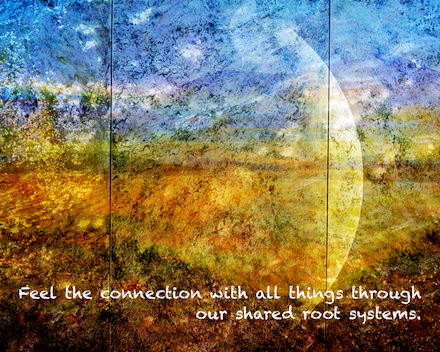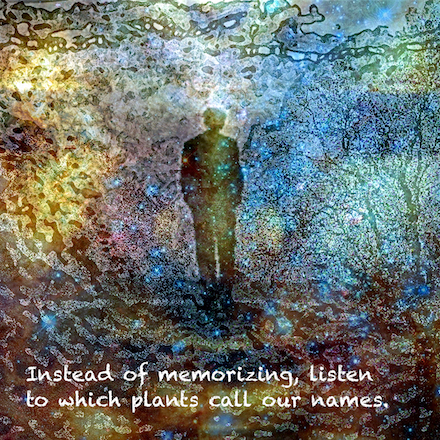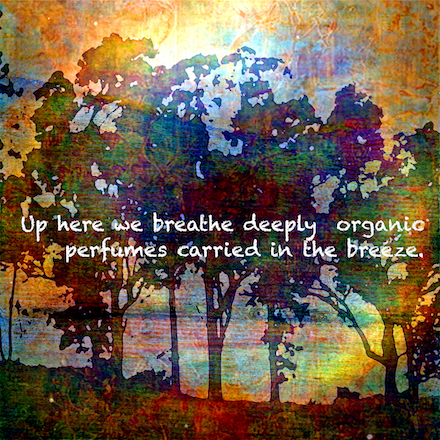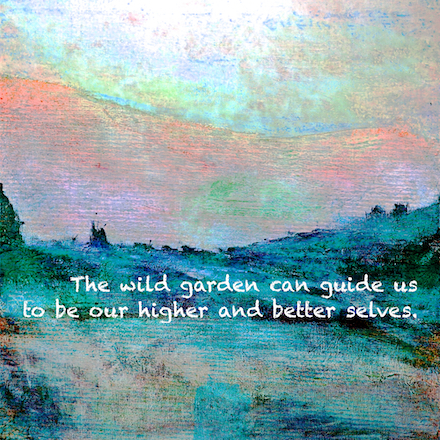
|
|
|
|
|
| Issue 28: | April 2025 |
| Visual Poetry: | 70 words |
| + Artist’s Intro: | 318 words |
By Kendall Johnson
Words and Visual Art
Seeing the Shifting Wild: Six Visual Poems
In the previous issue of MacQueen’s Quinterly, I completed the seventh in a series of reflective essays entitled Writing for Vision.* Given the speed and far-reaching consequences of recent world changes, I had needed to examine the basis for how I see the earth, for how my reaction to this murky state of affairs is affected by how I see it, and the meaning this process itself holds for our coming days.
I’m working on a project about a piece of wildland close to me—words, paintings, and photographs that will appear on exhibit in early fall. The purpose of both the essays and the exhibit has been to explore Johnson’s Pasture with fresh eyes: as wildland facing imminent degradation caused by rapid climate change and political fracture.
The visual poems presented here address two issues: the changes in the land, as well as suggestions on how to see the place, and all such wild places, differently. These resulting images help me see that I can choose how I look at the world and, as a result, what I can see.

Copyrighted © 2025 by Kendall Johnson. All rights reserved.

Copyrighted © 2025 by Kendall Johnson. All rights reserved.

Copyrighted © 2025 by Kendall Johnson. All rights reserved.

Copyrighted © 2025 by Kendall Johnson. All rights reserved.

Copyrighted © 2025 by Kendall Johnson. All rights reserved.

Copyrighted © 2025 by Kendall Johnson. All rights reserved.
When we walk in wild land (and in a sense all of our walks are in the wild because we all have the wild flowing within us), we can look for bits of glowing beauty, however dark and however transient we may fear them to be. The wild abounds in sacred mystery—links to the very stuff of the universe are always and everywhere. Wild lands invite seeing a world unsullied, anew. What we look for and how open we are to seeing it frames our world. Our vision determines whether we find joy or suffering in what we see and the things we do.
*Publisher’s Notes:
1. The Writing for Vision series appeared across five issues (23-27) of MacQueen’s Quinterly online, and will be published by MacQ as a printed book this summer.
2. Here are links to the seven essays of Kendall Johnson’s Writing for Vision series:
Part 1: Interior Lighting: Abstraction and the Concrete, Issue 23 (April 2024)
Part 2: Grounding: What Land Art Tells Us of the Long Walk Home, Issue 24 (August 2024)
Part 3: Seeing Beyond the Clamorous Now, Issue 25 (September 2024)
Part 4: Fields of Vision, Issue 26 (January 2025)
Part 5: Losing Light, Issue 26 (January 2025)
Part 6: Slanting Light: Voicing the New Wild, Issue 27 (March 2025)
Part 7: Vision, Issue 27 (March 2025)
3. On a related note: The six essays of Johnson’s Writing to Heal series are published in MacQueen’s Quinterly online (Issues 16-19, 20X, and 22), as well as in a printed collection released by MacQ in May 2024. The book also includes a few of his poems and 21 of his artworks in full color, as described in Issue 23 of MacQ:
Writing to Heal: Self-Care for Creators
Kendall Johnson
grew up in the lemon groves in Southern California, raised by assorted coyotes and bobcats. A former firefighter with military experience, he served as traumatic stress therapist and crisis consultant—often in the field. A nationally certified teacher, he taught art and writing, served as a gallery director, and still serves on the board of the Sasse Museum of Art, for whom he authored the museum books Fragments: An Archeology of Memory (2017), an attempt to use art and writing to retrieve lost memories of combat, and Dear Vincent: A Psychologist Turned Artist Writes Back to Van Gogh (2020). He holds national board certification as an art teacher for adolescents to young adults.
Dr. Johnson retired from teaching and clinical work a few years ago to pursue painting, photography, and writing full time. In that capacity he has written a book on art history, and six books of artwork and literary poetry, including most recently Prayers for Morning: Twenty Quartets, a collaboration with poets Kate Flannery and John Brantingham released on Christmas Day, 2024 by MacQ.
MacQ also published Dr. Johnson’s hybrid collection of essays, memoir, poetry, and visual art: Writing to Heal: Self-Care for Creators (May 2024). His memoir collection, Chaos & Ash, was released from Pelekinesis in 2020, his Black Box Poetics from Bamboo Dart Press in 2021, and his The Stardust Mirage from Cholla Needles Press in 2022. His Fireflies series is published by Arroyo Seco Press: Fireflies Against Darkness (2021), More Fireflies (2022), and The Fireflies Around Us (2023).
His shorter work has appeared in Chiron Review, Cultural Weekly, Literary Hub, MacQueen’s Quinterly, Quarks Ediciones Digitales, and Shark Reef; and was translated into Chinese by Poetry Hall: A Chinese and English Bi-Lingual Journal. He serves as contributing editor for the Journal of Radical Wonder.
Author’s website: www.layeredmeaning.com
More on the Web: By, About, and Beyond
⚡ Seeing Beyond the Clamorous Now, an essay and paintings by Kendall Johnson in Issue 25 of MacQueen’s Quinterly (September 2024); nominated by MacQ for the Pushcart Prize
⚡ Through a Curatorial Eye: The Apocalypse This Time, an essay and paintings by Johnson in Issue 19 of MacQueen’s Quinterly (August 2023); nominated by MacQ for the Pushcart Prize
⚡ Kendall Johnson’s Black Box Poetics is out today on Bamboo Dart Press, an interview by Dennis Callaci in Shrimper Records blog (10 June 2021)
⚡ Self Portraits: A Review of Kendall Johnson’s Dear Vincent, by Trevor Losh-Johnson in The Ekphrastic Review (6 March 2020)
⚡ On the Ground Fighting a New American Wildfire at Literary Hub (12 August 2020), a selection from Kendall Johnson’s memoir collection Chaos & Ash (Pelekinesis, 2020)
⚡ A review of Chaos & Ash by John Brantingham in Tears in the Fence (2 January 2021)
| Copyright © 2019-2025 by MacQueen’s Quinterly and by those whose works appear here. | |
| Logo and website designed and built by Clare MacQueen; copyrighted © 2019-2025. | |
|
Data collection, storage, assimilation, or interpretation of this publication, in whole or in part, for the purpose of AI training are expressly forbidden, no exceptions. |
At MacQ, we take your privacy seriously. We do not collect, sell, rent, or exchange your name and email address, or any other information about you, to third parties for marketing purposes. When you contact us, we will use your name and email address only in order to respond to your questions, comments, etc.